Mad cow disease other names. Mad Cow Disease: Understanding BSE and Its Impact on Human Health
What is Mad Cow Disease. How does BSE spread. Can humans contract the disease. What measures are in place to prevent BSE. How is the disease diagnosed. What are the symptoms of vCJD in humans. How has BSE affected the global beef industry.
The Origins and Nature of Mad Cow Disease
Mad Cow Disease, scientifically known as Bovine Spongiform Encephalopathy (BSE), is a progressive neurological disorder affecting cattle. This fatal brain disease belongs to a family of diseases called transmissible spongiform encephalopathies (TSEs), which are caused by abnormal proteins called prions.
BSE first emerged as a significant concern in the United Kingdom during the 1980s, sparking widespread panic and leading to substantial changes in the beef industry worldwide. The disease’s ability to potentially transmit to humans, causing variant Creutzfeldt-Jakob Disease (vCJD), has made it a critical public health issue.
How does BSE develop and spread?
BSE develops when cattle consume feed contaminated with the infectious prion protein. These prions can originate from the rendered remains of other cattle or sheep affected by a similar disease called scrapie. Once ingested, the prions cause normal proteins in the brain to misfold, leading to brain damage and eventual death.
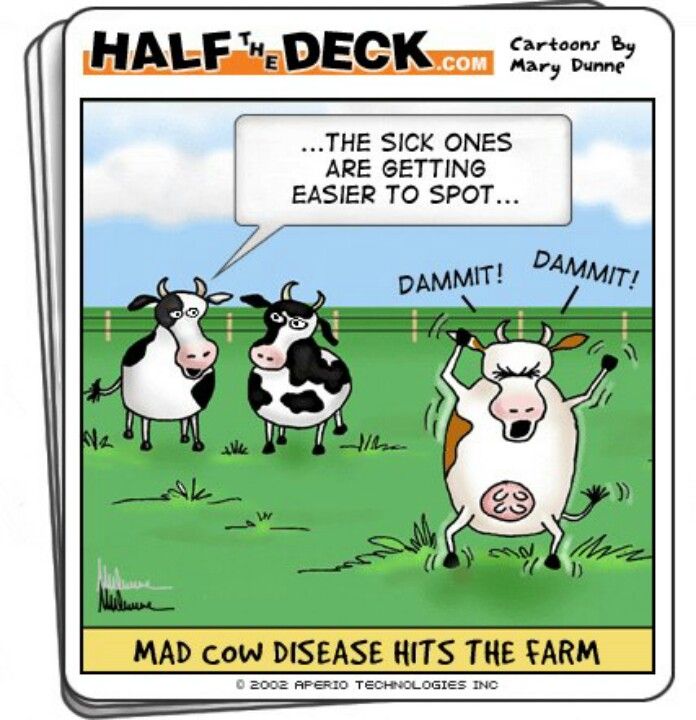
- Incubation period: 2 to 8 years
- Primary mode of transmission: Contaminated feed
- Affected organ: Central nervous system
The First BSE Case in the United States
On December 23, 2003, the U.S. Department of Agriculture (USDA) announced the first presumptive diagnosis of BSE in the United States. The case involved an adult Holstein cow from Washington State, later confirmed by an international reference laboratory in Weybridge, England.
Details of the first U.S. BSE case:
- Date of announcement: December 23, 2003
- Location: Washington State
- Animal: Adult Holstein cow
- Origin: Imported from Canada in August 2001
The infected cow was identified through USDA’s targeted surveillance program for BSE, which focuses on testing non-ambulatory or “downer” cows. Despite being flagged for testing, the animal’s condition was initially attributed to calving complications, and its carcass was released for human consumption after inspection.
What actions were taken following the discovery?
Upon confirmation of the BSE case, several immediate actions were taken:

- Recall of beef from cattle slaughtered in the same plant on the same day
- Launch of an epidemiologic investigation to determine the disease source
- Increased cooperation between U.S. and Canadian agricultural authorities
- Enhancement of existing BSE surveillance and prevention measures
The Human Health Risk: Variant Creutzfeldt-Jakob Disease (vCJD)
The primary concern surrounding BSE is its potential to cause variant Creutzfeldt-Jakob Disease (vCJD) in humans. vCJD is a rare, degenerative brain disorder believed to be caused by consuming beef products contaminated with the BSE agent.
What is the link between BSE and vCJD?
Strong evidence suggests that BSE can be transmitted to humans, primarily through the consumption of contaminated beef products. This transmission results in vCJD, a fatal neurological disorder with no known cure.
As of December 1, 2003, a total of 153 vCJD cases had been reported worldwide, with 143 of these occurring in the United Kingdom. The relatively low number of human cases, considering the widespread BSE outbreak in cattle, indicates a substantial species barrier that appears to protect humans from widespread illness.
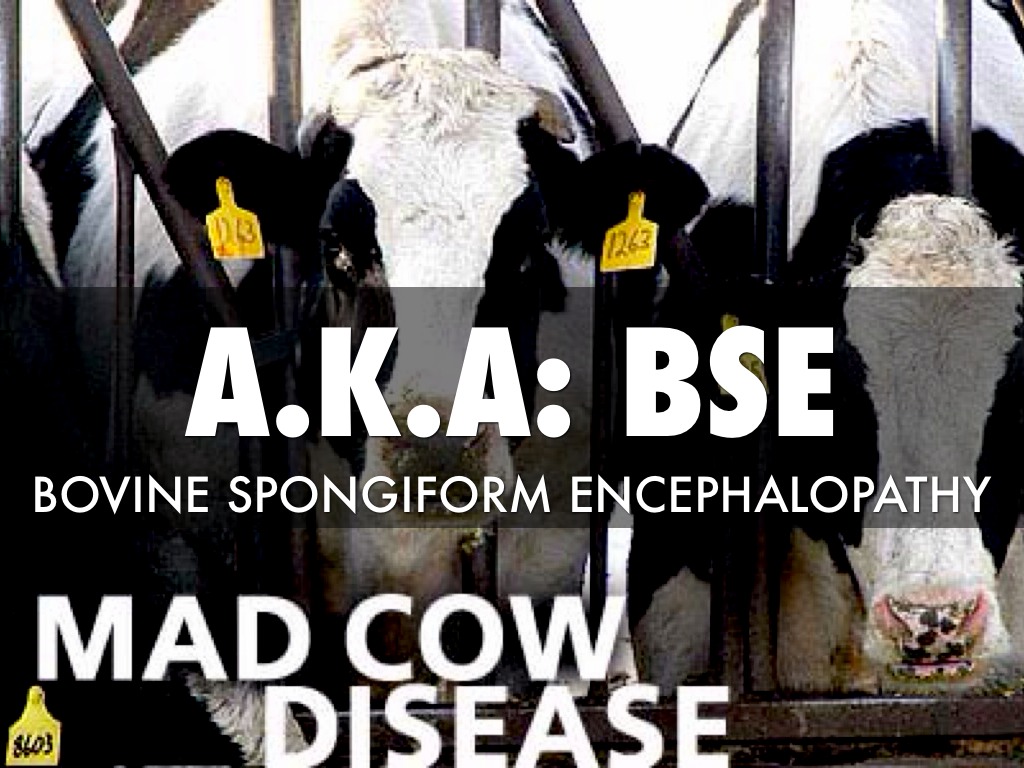
What are the symptoms of vCJD in humans?
vCJD typically presents with the following symptoms:
- Depression and anxiety
- Persistent painful sensations
- Difficulty with coordination and balance
- Memory loss and cognitive decline
- Involuntary movements
- Progressive neurological deterioration
It’s important to note that these symptoms can be similar to other neurological disorders, making early diagnosis challenging.
Surveillance and Monitoring of Prion Diseases in the United States
Following the BSE scare, the United States implemented robust surveillance and monitoring systems to track and prevent the spread of prion diseases, including BSE and vCJD.
How does the CDC monitor prion diseases?
The Centers for Disease Control and Prevention (CDC) employs several strategies to monitor prion diseases:
- Analysis of death certificate information from U.S. multiple cause-of-death data
- Follow-up review of clinical and neuropathology records of CJD decedents younger than 55 years
- Collaboration with the National Prion Disease Pathology Surveillance Center
The National Prion Disease Pathology Surveillance Center, established in 1996-1997 at Case Western Reserve University, provides free diagnostic services to U.S. physicians and helps monitor for emerging forms of prion diseases, such as vCJD.

Prevention Measures Against BSE Spread
To prevent BSE from entering and spreading within the United States, several stringent measures have been implemented.
What import restrictions are in place?
Severe restrictions have been placed on the importation of live ruminants (such as cattle, sheep, and goats) and certain ruminant products from countries where BSE is known to exist. These restrictions were later extended to include all European countries.
How has animal feed regulation changed?
The use of ruminant tissue in ruminant feed has been banned, as this practice was identified as a primary route of BSE transmission. This feed ban has been a crucial step in preventing the spread of BSE within cattle populations.
Diagnosis and Testing for BSE
Accurate and timely diagnosis of BSE is crucial for containing its spread and protecting public health.
How is BSE diagnosed in cattle?
BSE diagnosis involves several steps:
- Clinical observation of neurological symptoms
- Post-mortem examination of brain tissue
- Histopathological analysis
- Immunohistochemical testing
- Confirmation by international reference laboratories
It’s important to note that definitive diagnosis can only be made post-mortem, which underscores the importance of robust surveillance systems.

Global Impact of BSE on the Beef Industry
The discovery of BSE has had far-reaching consequences for the global beef industry, affecting trade, consumer confidence, and agricultural practices.
How has BSE affected international beef trade?
The BSE crisis led to significant disruptions in international beef trade:
- Implementation of trade bans on beef from affected countries
- Increased scrutiny and testing requirements for beef exports
- Shifts in global beef consumption patterns
- Economic losses for beef-producing nations affected by BSE
These impacts have prompted countries to enhance their food safety measures and traceability systems to regain consumer trust and maintain market access.
What changes have been made to cattle farming practices?
The BSE crisis has led to significant changes in cattle farming practices globally:
- Implementation of strict feed regulations
- Enhanced surveillance and testing programs
- Improved animal identification and traceability systems
- Increased focus on biosecurity measures
- Development of alternative protein sources for animal feed
These changes aim to prevent the spread of BSE and other prion diseases while ensuring the safety of beef products for human consumption.
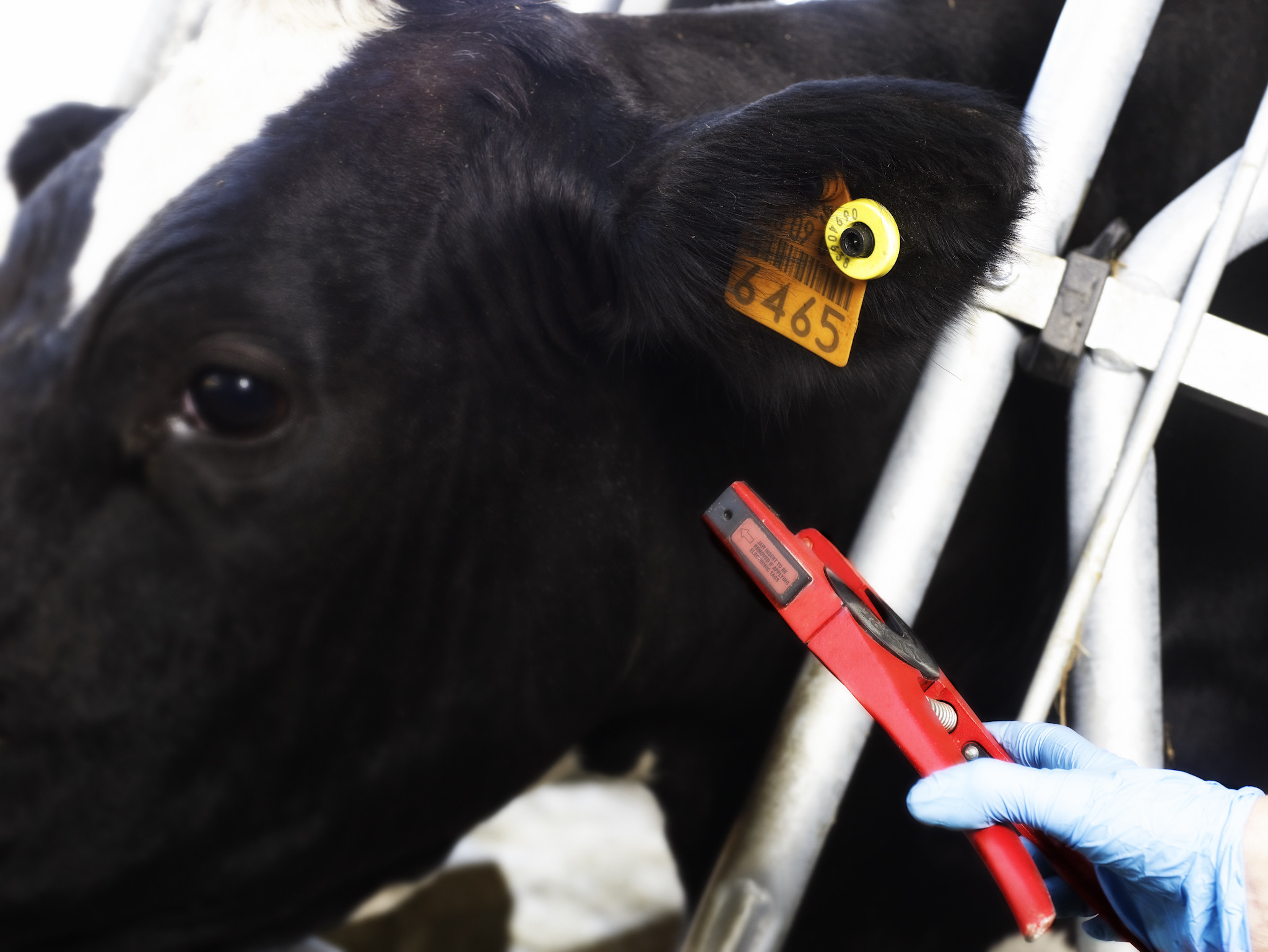
Future Outlook and Ongoing Research
While significant progress has been made in understanding and controlling BSE, ongoing research continues to explore various aspects of the disease.
What are the current research priorities?
Current research priorities in the field of BSE and related prion diseases include:
- Developing more sensitive and rapid diagnostic tests
- Exploring potential treatments for prion diseases in humans and animals
- Investigating the mechanisms of prion transmission and species barrier
- Enhancing surveillance techniques for early detection
- Studying the long-term effects of BSE prevention measures on cattle health and productivity
These research efforts aim to further reduce the risk of BSE and improve our ability to respond to future challenges posed by prion diseases.
How has our understanding of prion diseases evolved?
Since the emergence of BSE, our understanding of prion diseases has advanced significantly:
- Improved knowledge of prion protein structure and function
- Better understanding of the mechanisms of prion transmission and propagation
- Recognition of the role of genetic factors in susceptibility to prion diseases
- Identification of potential therapeutic targets for prion diseases
- Enhanced appreciation of the interconnectedness of animal and human health (One Health approach)
This evolving understanding continues to inform public health policies and agricultural practices worldwide.
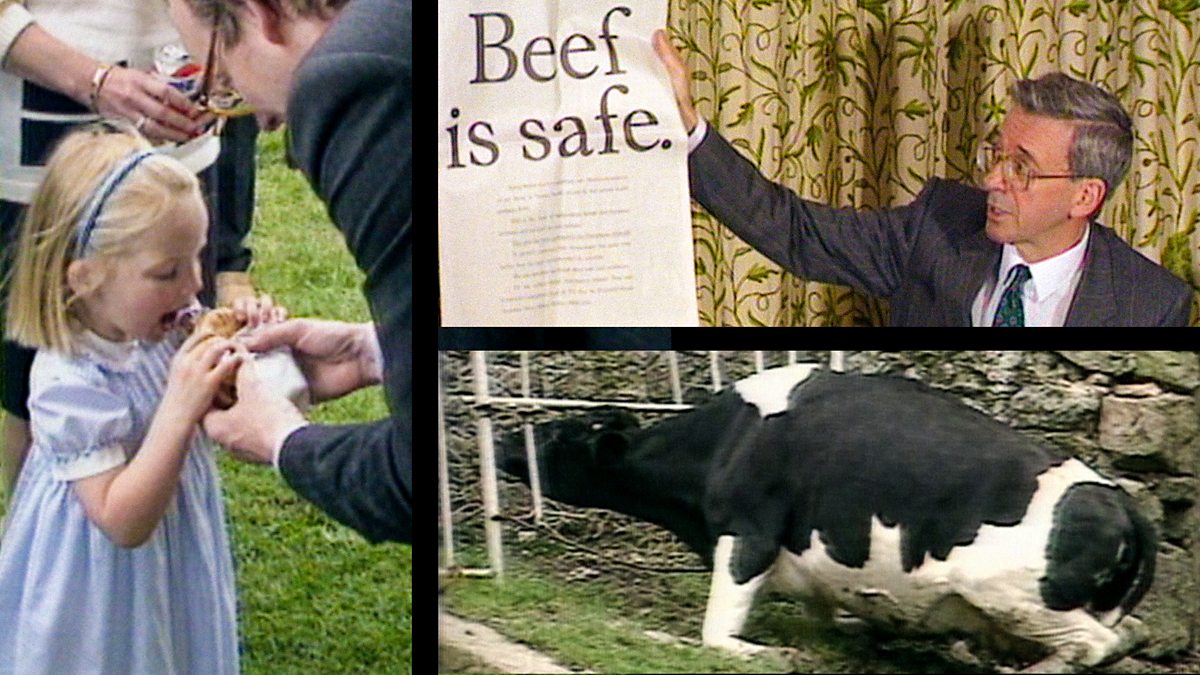
The Role of International Cooperation in BSE Control
The global nature of the BSE threat has necessitated unprecedented levels of international cooperation in disease surveillance, prevention, and control.
How do countries collaborate on BSE control?
International cooperation on BSE control takes various forms:
- Sharing of surveillance data and research findings
- Harmonization of testing and diagnostic procedures
- Coordinated response to BSE outbreaks
- Joint development of prevention strategies
- Collaborative research initiatives
Organizations such as the World Organisation for Animal Health (OIE) and the World Health Organization (WHO) play crucial roles in facilitating this international cooperation.
What global standards exist for BSE control?
Several global standards and guidelines have been established to promote consistent BSE control measures across countries:
- OIE Terrestrial Animal Health Code guidelines on BSE
- WHO recommendations on vCJD prevention
- Codex Alimentarius standards for food safety related to BSE
- International agreements on trade measures related to BSE
These standards help ensure a coordinated global approach to BSE prevention and control, facilitating safer international trade in cattle and beef products.

Public Perception and Consumer Awareness
The BSE crisis has significantly impacted public perception of food safety and has led to increased consumer awareness about the origins and processing of beef products.
How has BSE affected consumer behavior?
The BSE crisis has influenced consumer behavior in several ways:
- Increased demand for information about beef origin and processing
- Greater interest in alternative protein sources
- Heightened awareness of food safety issues
- Changes in beef consumption patterns in affected countries
- Increased support for organic and grass-fed beef products
These changes have prompted the beef industry to adapt its practices and communication strategies to address consumer concerns.
What role does public education play in BSE prevention?
Public education plays a crucial role in BSE prevention and control:
- Raising awareness about the nature of BSE and its transmission
- Informing consumers about food safety measures and regulations
- Promoting understanding of the low risk of vCJD in countries with strong BSE controls
- Encouraging support for continued surveillance and research efforts
- Fostering trust in food safety systems and regulatory bodies
Effective public education helps maintain consumer confidence in beef products while supporting ongoing efforts to prevent and control BSE.

Economic Implications of BSE Outbreaks
BSE outbreaks can have severe economic consequences, affecting not only the beef industry but also related sectors and national economies.
What are the direct costs associated with BSE outbreaks?
Direct costs of BSE outbreaks include:
- Culling of infected and at-risk cattle
- Compensation to farmers for destroyed animals
- Implementation of enhanced testing and surveillance programs
- Disposal of specified risk materials
- Increased regulatory oversight and enforcement
These costs can place significant financial strain on both the industry and government resources.
How do BSE outbreaks impact related industries?
The impact of BSE outbreaks extends beyond the beef industry:
- Reduced demand for animal feed products
- Decreased sales in the foodservice and restaurant sectors
- Negative effects on tourism in rural areas
- Impacts on leather and other cattle by-product industries
- Increased costs for pharmaceuticals and medical products that use bovine materials
These wide-ranging economic impacts underscore the importance of effective BSE prevention and control measures.
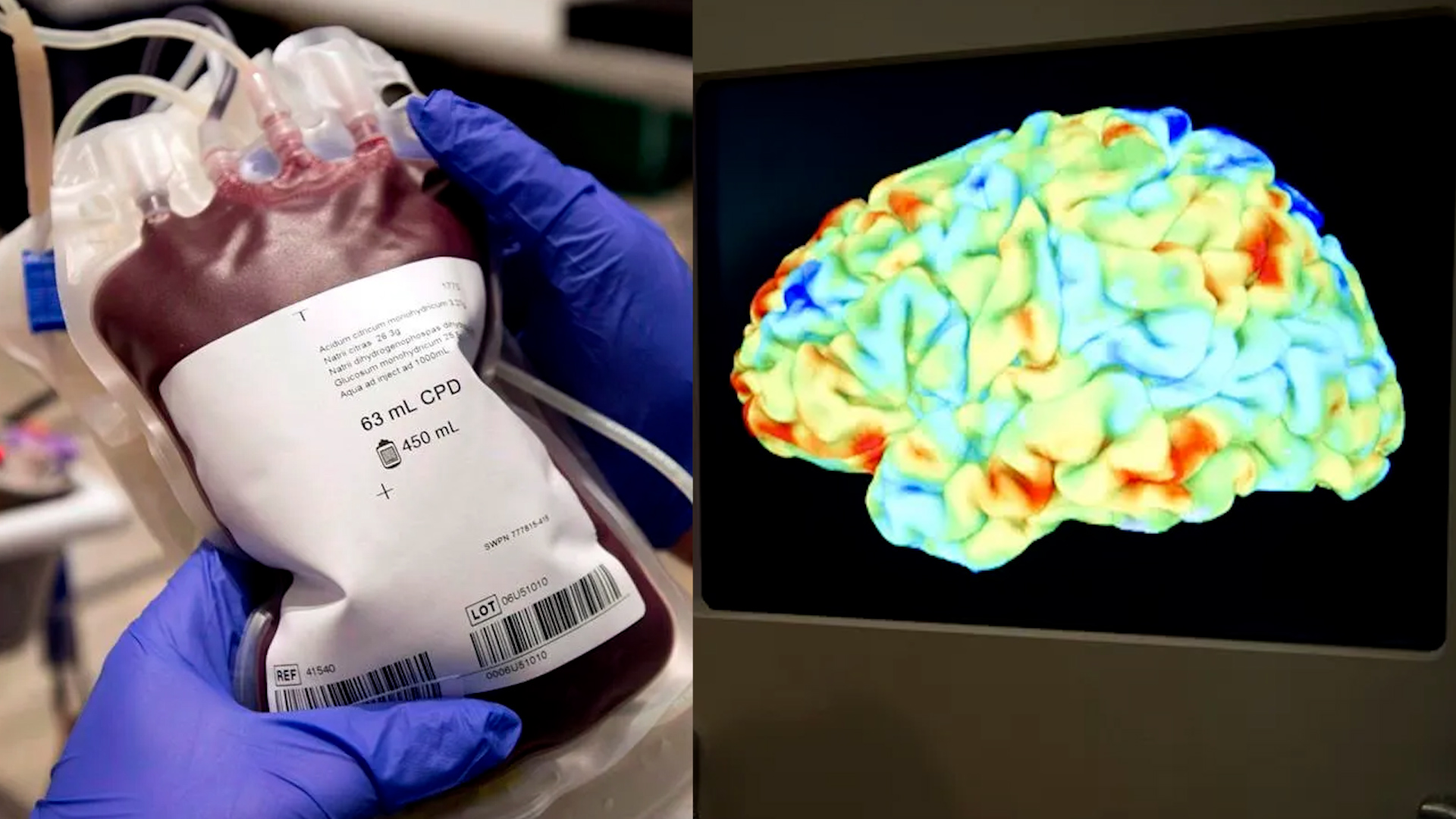
The Future of BSE Management
As our understanding of BSE evolves, so too do the strategies for managing and preventing the disease.
What emerging technologies show promise in BSE control?
Several emerging technologies hold potential for improving BSE control:
- Advanced genomic testing for BSE susceptibility
- Novel prion detection methods using nanotechnology
- Artificial intelligence-driven surveillance systems
- Gene editing techniques to develop BSE-resistant cattle
- Innovative feed processing technologies to eliminate prion contamination
These technologies may offer new tools for more effective BSE prevention and control in the future.
How might climate change affect BSE risk?
The potential impacts of climate change on BSE risk are an emerging area of concern:
- Changes in global agricultural patterns may affect feed production and composition
- Altered distribution of wildlife populations could introduce new prion disease risks
- Stress on cattle due to extreme weather events might influence disease susceptibility
- Shifts in global trade patterns could affect the movement of cattle and beef products
- Environmental changes might impact the survival and spread of prions in the environment
Understanding these potential impacts will be crucial for adapting BSE control strategies in a changing climate.

BSE Cases Identified in the United States BSE (Bovine Spongiform Encephalopathy) | Prion Diseases
On December 23, 2003, the U.S. Department of Agriculture (USDA) announced a presumptive diagnosis of the first known case of BSE in the United States. It was in an adult Holstein cow from Washington State. This diagnosis was confirmed by an international reference laboratory in Weybridge, England, on December 25. Trace-back based on an ear-tag identification number and subsequent genetic testing confirmed that the BSE-infected cow was imported into the United States from Canada in August 2001.
Because the animal was non-ambulatory (a “downer cow”) at slaughter, brain tissue samples were taken by USDA’s Animal and Plant Health Inspection Service as part of its targeted surveillance for BSE. However the animal’s condition was attributed to complications from calving. After the animal was examined by a USDA Food Safety and Inspection Service (FSIS) veterinary medical officer both before and after slaughter, the carcass was released for use as food for human consumption. During slaughter, the tissues considered to be at high risk for the transmission of the BSE agent were removed.
During slaughter, the tissues considered to be at high risk for the transmission of the BSE agent were removed.
On December 24, 2003, FSIS recalled beef from cattle slaughtered in the same plant on the same day as the BSE positive cow. (see Bovine Spongiform Encephalopathy in a Dairy Cow—Washington State, 2003.)
Preliminary Investigation Suggests BSE-Infected Cow in Washington State Was Likely Imported from Canada
On December 23, 2003, the U.S. Department of Agriculture (USDA) announced a presumptive diagnosis of bovine spongiform encephalopathy (BSE, or “mad cow” disease) in an adult Holstein cow from Washington State. Samples were taken from the cow on December 9 as part of USDA’s BSE surveillance program. The BSE diagnosis was made on December 22 and 23 by histopathology and immunohistochemical testing at the National Veterinary Services Laboratory, Ames, Iowa. The diagnosis was confirmed by an international reference laboratory in Weybridge, England, on December 25. Preliminary trace-back based on an ear-tag identification number suggests that the BSE-infected cow was imported into the United States from Canada in August 2001.
Preliminary trace-back based on an ear-tag identification number suggests that the BSE-infected cow was imported into the United States from Canada in August 2001.
USDA, in close cooperation with Canadian agricultural authorities, has launched an epidemiologic investigation to determine the source of the disease. Beef from the slaughtered cow had been processed for human consumption. On December 23, 2003, the Food Safety and Inspection Service (FSIS), USDA announced the recall of all beef from cattle slaughtered on December 9 at the involved slaughter plant.
Strong evidence indicates that BSE has been transmitted to humans primarily in the United Kingdom, causing a variant form of Creutzfeldt-Jakob disease (vCJD). In the United Kingdom, where over 1 million cattle may have been infected with BSE, a substantial species barrier appears to protect humans from widespread illness. As of December 1, 2003, a total of 153 vCJD cases had been reported worldwide; of these, 143 cases had occurred in the United Kingdom. The risk to human health from BSE in the United States is extremely low.
The risk to human health from BSE in the United States is extremely low.
CDC monitors the trends and current incidence of CJD in the United States by analyzing death certificate information from U.S. multiple cause-of-death data compiled by the National Center for Health Statistics. With the support of the Council of State and Territorial Epidemiologists, CDC conducts follow-up review of clinical and neuropathology records of CJD decedents younger than 55 years of age. In addition, during 1996-1997, in collaboration with the American Association of Neuropathologists (AANP), CDC established the National Prion Disease Pathology Surveillance Centerexternal icon at Case Western Reserve University in Cleveland, Ohio. This pathology center provides free, state-of-the-art diagnostic services to U.S. physicians. It also helps to monitor the possible occurrence of emerging forms of prion diseases, such as vCJD, in the United States. For more information about the center visit its website at:
- United States Department of Agriculture’s (USDA): BSE Surveillance Information Centerexternal icon
- FDA Bovine Spongiform Encephalopathy external icon
- CDC Prion Diseases
- NIH NINDS Creutzfeldt-Jakob Disease Information Pageexternal icon
Prevention BSE (Bovine Spongiform Encephalopathy) | Prion Diseases
Prevention Measures against BSE Spread
To prevent BSE from entering the United States, severe restrictions were placed on the importation of live ruminants, such as cattle, sheep, and goats, and certain ruminant products from countries where BSE was known to exist. These restrictions were later extended to include importation of ruminants and certain ruminant products from all European countries.
These restrictions were later extended to include importation of ruminants and certain ruminant products from all European countries.
Because the use of ruminant tissue in ruminant feed was probably a necessary factor responsible for the BSE outbreak in the United Kingdom and because of the current evidence for possible transmission of BSE to humans, the U.S. Food and Drug Administration instituted a ruminant feed ban in June 1997 that became fully effective as of October 1997. As of October 26, 2009, a regulation issued by FDA in April 2009 came into effect establishing an enhanced BSE-related feed ban in the U.S. This enhanced feed ban will further harmonize BSE feed control measures in the U.S. with those in Canada (see below). In addition, FDA continues to enforce its important 1997 mammalian-to-ruminant feed ban through its BSE inspection and BSE feed testing programs.
As of July 12, 2007, an enhanced BSE-related feed ban came into effect in Canada. CFIA established this ban to more effectively prevent and quickly eliminate BSE from Canada. The enhanced ban prohibits most proteins, including potentially BSE infectious tissues known as “specified risk materials” (SRM) from all animal feeds, pet foods, and fertilizers, not just from cattle feed as required by the ban instituted in 1997. The 1997 feed ban in Canada was similar to the feed ban instituted in the United States that same year. As recently reported by CFIA, removing SRM from the entire animal feed system addresses risks associated with the potential contamination of cattle feed during production, distribution, storage, and use. Applying the same measure to pet food and fertilizer materials addresses the possible exposure of cattle and other susceptible animals to these products. With this ban in place, CFIA expects BSE should be eliminated from the Canadian cattle herd by about the year 2017.
The enhanced ban prohibits most proteins, including potentially BSE infectious tissues known as “specified risk materials” (SRM) from all animal feeds, pet foods, and fertilizers, not just from cattle feed as required by the ban instituted in 1997. The 1997 feed ban in Canada was similar to the feed ban instituted in the United States that same year. As recently reported by CFIA, removing SRM from the entire animal feed system addresses risks associated with the potential contamination of cattle feed during production, distribution, storage, and use. Applying the same measure to pet food and fertilizer materials addresses the possible exposure of cattle and other susceptible animals to these products. With this ban in place, CFIA expects BSE should be eliminated from the Canadian cattle herd by about the year 2017.
In late 2001, the Harvard Center for Risk Assessment study of various scenarios involving BSE in the U.S. concluded that the FDA ruminant feed rule provides a major defense against this disease.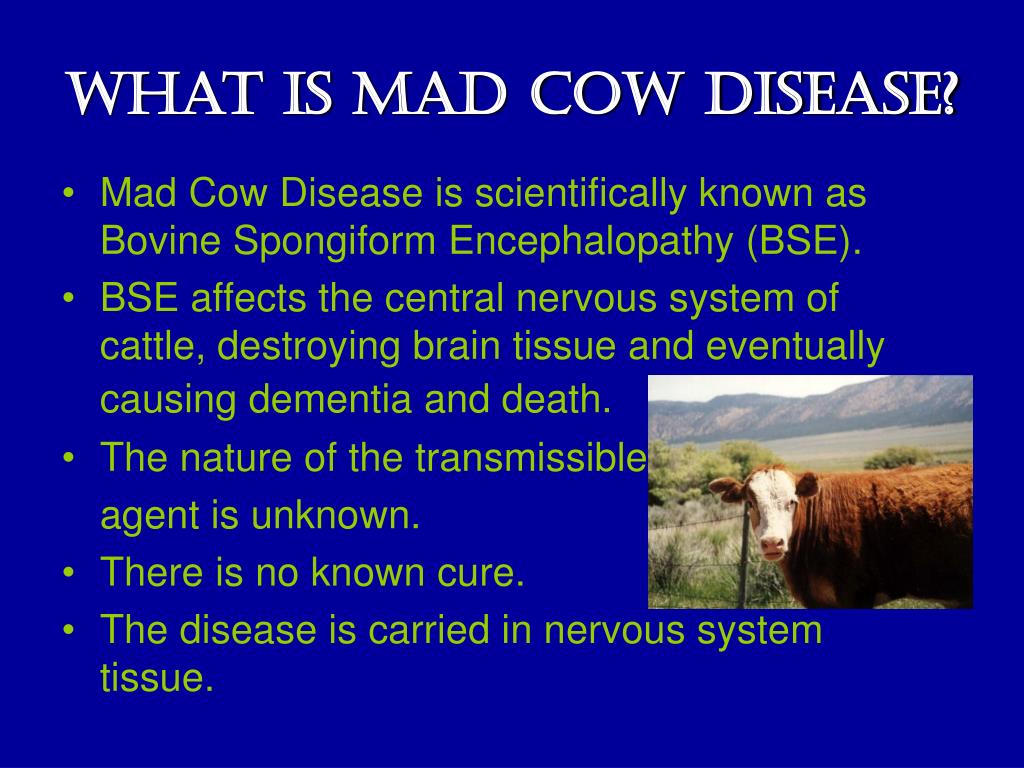
BSE/TSE Action Plan of the Department of Health and Human Services (DHHS)
On August 23, 2001, the Department of Health and Human Services (HHS) issued a department-wide action plan outlining steps to improve scientific understanding of BSE and other transmissible spongiform encephalopathies (TSEs). The action plan has four major components:
Surveillance for human disease is primarily the responsibility of CDC.
Protection is primarily the responsibility of the Food and Drug Administration (FDA).
Research is primarily the responsibility of the National Institutes of Health (NIH).
Oversight is primarily the responsibility of the Office of the Secretary of DHHS.
Read the Department of Health and Human Services press release: USDA and HHS Strengthen Safeguards Against Bovine Spongiform Encephalopathyexternal icon
what you need to know about mad cow disease
The Department of Veterinary Medicine of the Sverdlovsk Region warns owners of cattle about the danger of importing into the country from disadvantaged zones or countries of breeding stock, meat, canned food, offal and semi-finished products, meat and bone meal, sperm, embryos, technical fat, intestinal raw materials and other products and feeds of animal origin from ruminants. In order to prevent mad cow disease infection, it is necessary to inform veterinary clinics in a timely manner.
In order to prevent mad cow disease infection, it is necessary to inform veterinary clinics in a timely manner.
What is mad cow disease?
Bovine spongiform encephalopathy (BSE), or mad cow disease, is a slowly developing infectious prion transmissible disease of adult cattle, characterized by a long, up to 2.5-8 years, incubation period and manifested by damage to the central nervous system with 100% mortality.
Historical reference.
Spongiform encephalopathy was first reported in 1985-1986 in the UK under the name “mad cow disease”. In the next 10 years, BSE spread to other countries: France, Portugal, Switzerland, Germany, the Netherlands, Italy, Denmark, Slovakia, Finland, etc.
scrapie cattle (scrapie) – a similar agent (causative agent of sheep scrapie), found in meat and bone meal, which was included in the diet of cattle. In Russia, the disease has not been registered.
Economic damage.
BSE caused enormous economic damage to European countries, due to the fact that about 4 million heads of cattle were destroyed. The UK alone suffered an economic loss of £7 billion.
Epizootological data.
Under natural conditions, cattle are susceptible to BSE, especially at 4 years of age. The source of the causative agent of infection are sick and animals in the incubation period. The factors of transmission of the infectious agent are the products of slaughter of sheep with scrapie, and cattle with EH.
Course and symptoms of the disease.
The incubation period is from 2.5 to 8 years, in some cases it can be extended up to 25-30 years. The course of the disease is progressive, without remissions. The disease proceeds without an increase in body temperature of the animal, with continued appetite. Despite a normal appetite, cows have reduced milk production.
The clinical manifestation of the disease is characterized by signs of damage to the central nervous system.
Three types of nervous phenomena are detected during GE.
- The first type of nervous phenomena is accompanied by the development in animals of a feeling of fear, nervousness, aggressiveness, gnashing of teeth, restlessness, timidity. The above symptoms occur in 98% of sick animals.
- The second type of nervous phenomena is characterized by the presence of movement disorders in sick animals: trotting movements, “raking in the front limbs”, “lowering” of the hind legs, raised tail
- In the third type of nervous phenomena, there is a violation of sensitivity, when in sick animals we note hyperesthesia with noise, touch and light. The duration of the disease is from several weeks to 12 months or more. The disease always ends in the death of the animal.
Pathological changes.
At autopsy of dead animals, characteristic pathoanatomical changes are either absent or mild.
Diagnosis.
Send to the laboratory for diagnostic tests:
– bovine brain after testing for rabies and other viral infections after the diagnosis was not confirmed;
– the brain of cattle from meat processing plants (0. 01% of slaughtered animals older than 3 years).
01% of slaughtered animals older than 3 years).
Pathological material (brain) is taken from animals with clinical signs of damage to the central nervous system). In this case, the brain for research must be taken from animals immediately after their slaughter or death.
Specific prophylaxis.
BSE does not produce either cellular or humoral immunity, so no vaccine has been developed in the world to date.
Treatment.
Treatment is ineffective, the prognosis for the disease is unfavorable.
Prevention.
The basis of prevention for prosperous countries is: preventing the importation of pedigree cattle, meat, canned food, by-products and semi-finished products, meat and bone meal, semen, embryos, technical fat, intestinal raw materials and other products and feeds of animal origin from ruminants; careful control over purchases of breeding stock and biological tissues, especially from disadvantaged countries; prohibition of feeding ruminants with meat-and-bone and bone meal from cattle and sheep.
If BSE is suspected, contact a veterinary clinic.
In order to prevent bovine spongiform encephalopathy, owners of susceptible animals must strictly comply with the requirements provided for in paragraph 7 of the Veterinary Rules for the implementation of preventive, diagnostic, restrictive and other measures, the establishment and lifting of quarantine and other restrictions aimed at preventing the spread and eliminating foci of large spongiform encephalopathy approved (hereinafter referred to as the Veterinary Rules), including paragraphs 6 and 7 of clause 7 of the Veterinary Rules regarding the incineration of waste from the slaughter of susceptible animals and the prohibition of feeding animals meat and bone, bone meal, protein briquettes, as well as other feed and feed additives for animals containing ruminant proteins in their composition.
In France, 3 people died of mad cow disease – RBC
adv. rbc.ru
rbc.ru
adv.rbc.ru
adv.rbc.ru
Hide banners
What is your location?
YesChoose other
Categories
Euro exchange rate on July 8
EUR CB: 99.82
(-0.9)
Investments, 07 Jul, 16:34
Dollar exchange rate on July 8
USD Central Bank: 91.69
(-0.88)
Investments, 07 Jul, 16:34
How dietary supplements became an everyday commodity
RBC+, 17:26
Commercial premises in residential complexes: where to find and how to buy
RBC and PIK, 17:13
Britain and Canada opposed the use of cluster bombs in Ukraine
Politics, 17:10
adv. rbc.ru
rbc.ru
adv.rbc.ru
The NHL said that Fedotov has no right to play in CSKA
Sport, 16:58
Zelensky announced the return of Azov commanders to Ukraine
Politics, 16:56
David de Gea left Manchester United after 12 years at the club
Sports, 16:55
How Russian universities use developments from the Russian software registry
RBC+, 16:52
Explaining what the news means
RBC Evening Newsletter
Subscribe
Extraction of innovations: how the R&D structures of metallurgical companies work
Trends, 16:50
How internal control services help investment companies and their clients
Industry, 16:31
The Foreign Ministry considered the supply of cluster munitions to Kyiv an attempt to delay the conflict
Politics, 16:31
Like BAM and Trans-Siberian: why are they building a private railway to the Pacific Ocean
RBC and ELSI, 16:30
Asset of last resort: why professional investors love gold
RBC+, 16:24
Ambassador announced Kiev’s support for 90% of “anti-Israeli” resolutions in the UN
Politics, 16:22
How the free school for aspiring entrepreneurs works
Trends, 16:09
adv. rbc.ru
rbc.ru
adv.rbc.ru
adv.rbc.ru
Arnaud Eboli, 19, died today in France of a human form of the disease known as mad cow disease or Creutzfeldt-Jakob disease.
At the end of December 2000, Erno’s parents, together with the relatives of another victim of “mad cow disease” – Laurence Duhamel, who died in February of this year – filed a lawsuit in the highest court of Paris against manufacturers of poor-quality meat products and achieved the opening of a judicial investigation into the fact ” manslaughter and intentional endangerment of human life.
It should be noted that the ban on the import of meat from most European countries was recently lifted in Russia. Countries such as Poland, the Czech Republic, Slovakia, Hungary, Bulgaria, Romania, Lithuania, Latvia and Estonia, in which no cases of FMD and mad cow disease have been detected in livestock, can now freely export meat to Russia. The ban remains on the import of all types of meat from the UK, Belgium, the Netherlands, Luxembourg, France and Holland.
